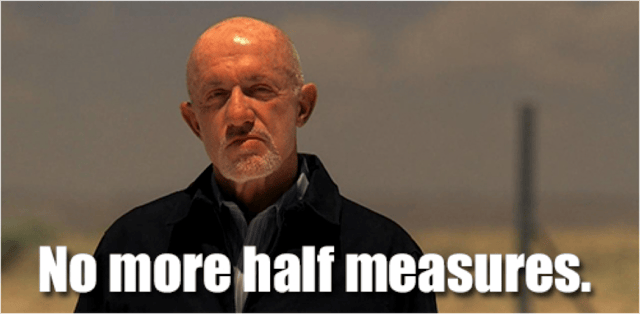 All the research said it was going to work. You read blogs, articles, guides, and anything you could find on inbound marketing. They all touted this new, innovative strategy as the next big thing. Businesses like HubSpot push statistics like how inbound tactics generate 54% more leads than traditional paid marketing. You decided to give up your old strategy and switch to inbound.
All the research said it was going to work. You read blogs, articles, guides, and anything you could find on inbound marketing. They all touted this new, innovative strategy as the next big thing. Businesses like HubSpot push statistics like how inbound tactics generate 54% more leads than traditional paid marketing. You decided to give up your old strategy and switch to inbound.
However, it isn’t working. You aren’t seeing any good leads, no increase in sales, no new customers. This was supposed to be the game changing plan that transformed your business, but nothing is different. In fact, things seem worse. How is this possible?
You just started
This is a common problem we see with our clients. After only a month of inbound marketing, they wonder why they aren’t seeing great results. The key thing to remember: Be Patient. Inbound marketing uses tactics like SEO, social media, and blogging. All three of these take a long time to produce noticeable effects.
It takes a while for search engines to index and rank pages, it takes time to grow a social following, and it takes time to write and attract people to a blog. Generally, we estimate a solid six months for significant improvement, but depending on the client, it can take even longer. Of course, it might happen for you in a few weeks and then might stagnate.
Don’t panic or freak out when your results aren’t what you expect. Focus on your analytics and strategy. Look for areas to improve, changes and causes, and where you can put in more effort. If you consistently don’t see any change for months and months on end, then something else is up.
You only took a half measure

If you are a Breaking Bad fan, you likely remember the famous speech by Mike Ehrmantraut on half measures. He states, “I chose a half measure, when I should have gone all the way. I’ll never make that mistake again.” In context, he didn’t complete his task because something held him back. He partially did what he knew was right but couldn’t go through with it, which ended up costing him in the end.
With inbound marketing, if you only go half way, you won’t succeed. You can’t expect to get results by posting one blog every few months, maybe updating your social media accounts on occasion when you remember, and updating your website then never touching it again. Inbound marketing requires constant vigilance. You have to always stay up to date on the industry and changes to best practices.
You never know when Google or Facebook are going to completely alter their algorithm, which could mess up your SEO or posting strategy. A new social media platform might emerge as a major player at some point, and it could be worthwhile to be an early adopter. Things in the digital world are in a constant state of change, so you can’t be stagnant in your strategy.
No half measures. Don’t waste your time and everyone else’s time. Boring content is going to get boring responses, if it gets any responses at all. Inbound experts might recommend posting three times a day on social media, so you decide to follow those instructions to no avail. However, are you posting anything interesting or just going through the motions? Take a closer look at your strategy, and see if there are any halves that should become wholes.
You are making it up as you go along
Maybe you are doing everything that you think is right and doing it to the best of your ability, but do you have an overarching strategy and plan? Inbound marketing relies on all the pieces of the puzzle working together to support a larger campaign. There needs to be some sort of goal in place that you are reaching for, otherwise what is the point?
SMART (specific, measureable, achievable, realistic, and timely) goals are helpful when planning because they give you something to focus on. You can’t just hope for the best and see what happens. If you are posting random thoughts on social media, blogging about your favorite lunch spots, targeting unrelated keywords, and sending out emails about the new office mascot, then you are setting yourself up to fail. Yes, you are following the basic principles of inbound marketing (in a way), but there is no development or goal in place.
Imagine instead that you are a clothing company and summer is quickly approaching. You decide to create a campaign to promote your new line of shorts. You consider your carefully crafted buyer persona of a 20-something male, athletic and outdoorsy, who loves the beach. Then, you create a landing page for a special offer on the shorts, which is promoted on your social media sites and on a PPC campaign. You also send out an email to your subscribers letting them know. Your efforts and planning pay off, and you end up selling out!
As you can see from that completely imaginary example, there is value in a strategy. It is not enough to just do everything; there should be some a reason why.
Your product or service simply isn’t good
According to the philosophical principle of Occam’s razor, when there are multiple explanations for an occurrence, in most cases the simplest answer is usually the right one. For example, if you notice one of your socks is missing, there are many possible reasons why. It might have been stolen by rats, abducted by aliens, eaten by a dog, or absorbed into your skin, but most likely you simply misplaced it.
In terms of inbound marketing, you can blame Google for not ranking your pages, hate Twitter for seemingly ignoring your posts, or your blog writer for writing poor content, but maybe the simple answer is your business just isn’t any good. The best marketing in the world probably wouldn’t be able to save the worst company in the world. If you have a product or service nobody wants, then sometimes, there is honestly nothing to be done. For example, if you sell oPhones, which are exactly like iPhones but cost 5x more, then you are probably going to be extremely unsuccessful.
Additionally, if your business is constantly getting scathing reviews on sites like Yelp or Google, then your problem might not be your marketing. You can put glitter on anything but that doesn’t make it shine like a diamond. A great product or service often speaks for itself, and marketing can help take it to another level. In-N-Out Burger constantly has a crazy line, even at random times like 10am or 4pm, but can you think of any commercials or advertising by them? I can’t, but I love visiting In-N-Out because of their exceptional product.
Inbound marketing can’t save a sinking ship. If you are in an ultra-competitive market (like the iPhone example) or have just plain bad customer service, then it will a rough road ahead. This isn’t to say that it is impossible. If you find a great niche or a loyal fan base, then there might be hope.
Final Thoughts
Inbound marketing isn’t a miracle worker. It can help your business, but it can’t solve all your problems. If you are just getting started in the world of digital and inbound marketing, you need to be patient and wait for results. Be aware that the results you might be looking for might never come if you refuse to put in the necessary effort or put together a coherent plan.
However, if you do everything correctly and thoroughly yet still don’t see any results, it might indicate a much deeper issue. Marketing can really only go so far, but if done correctly, it can boost your sales efforts and grow your business. If you don’t think you can do it yourself, there are always inbound marketing agencies, like Rhino, here to help.


Comments